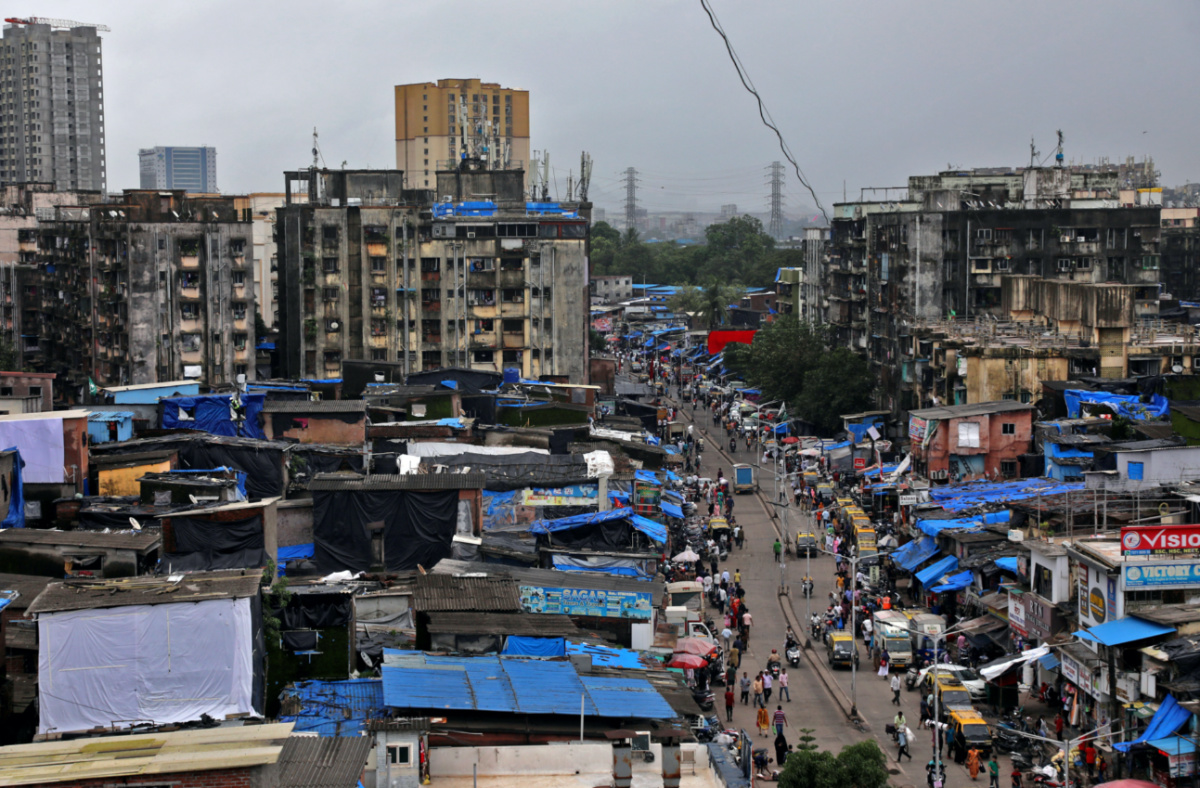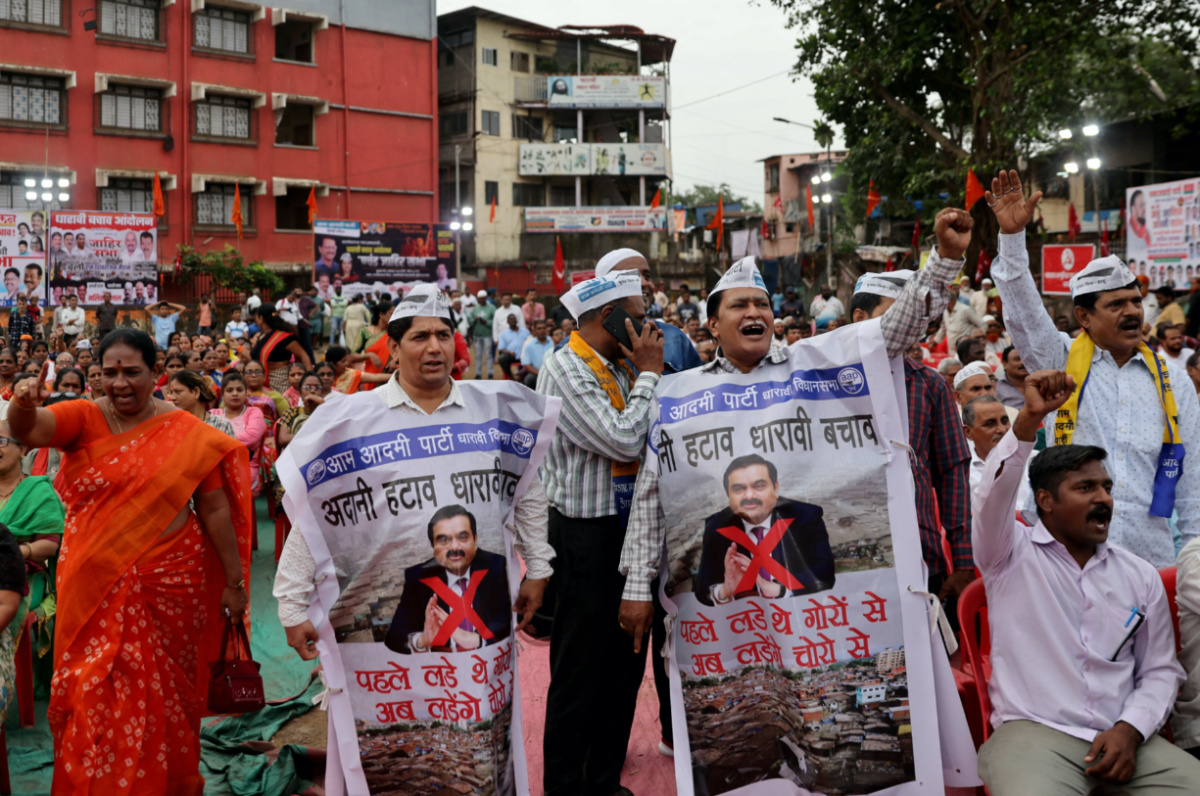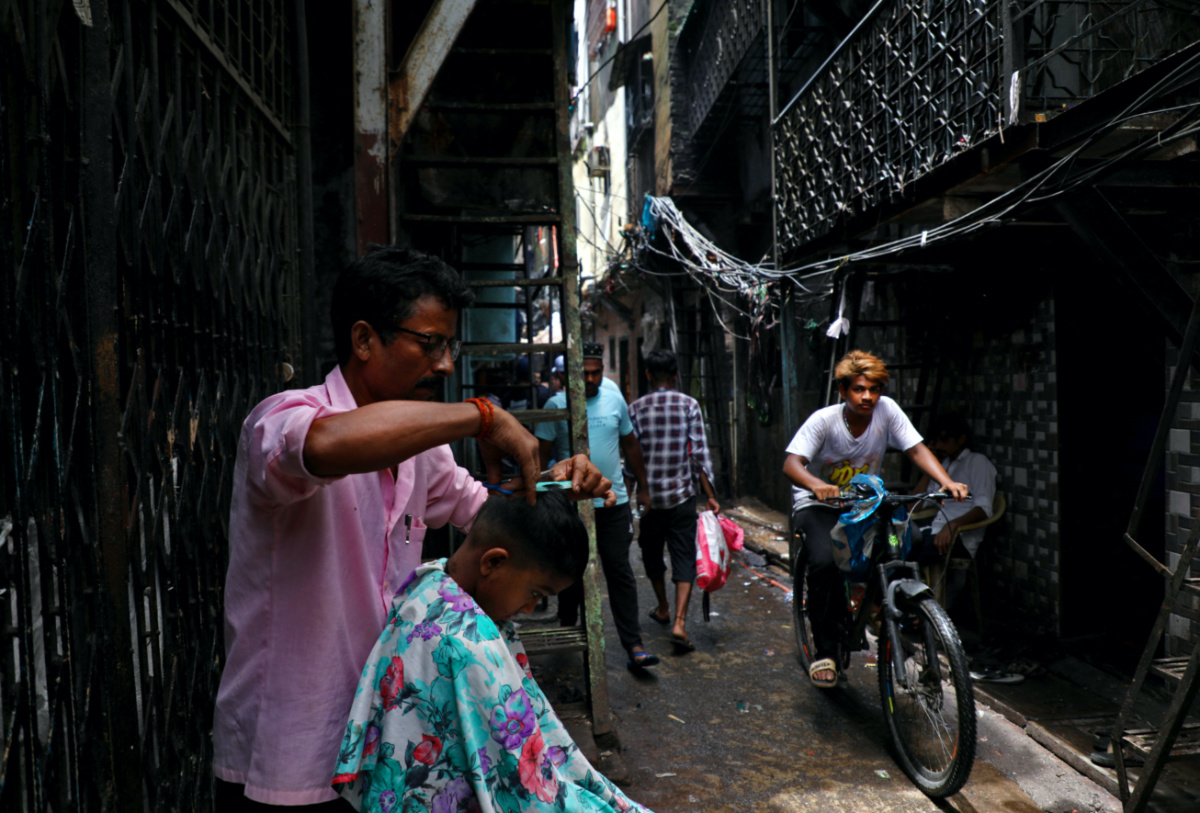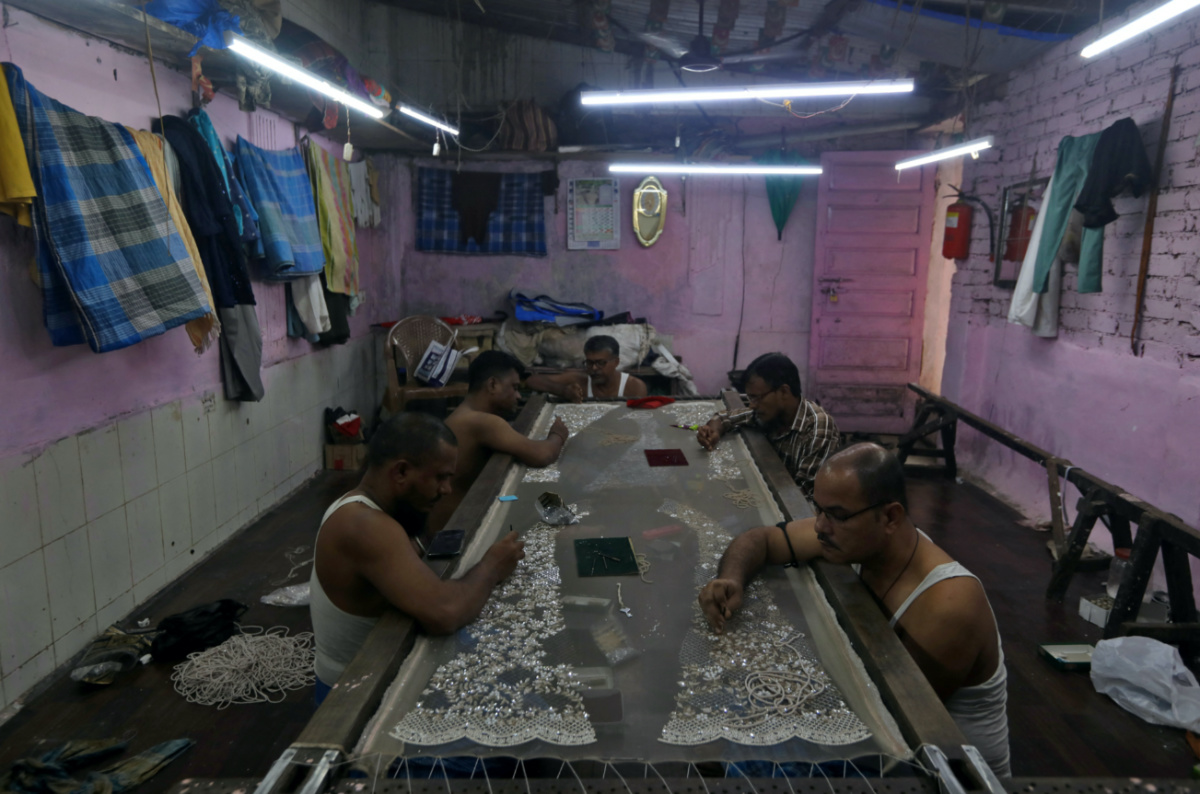
DHWANI PANDYA and ADITYA KALRA, of Reuters. report…
Mumbai, India
Reuters
Indian billionaire Gautam Adani’s plan to rehouse a million people living in one of Asia’s biggest slums is fuelling worries among residents about his capacity to deliver amid high-profile financial setbacks and allegations that Prime Minister Narendra Modi’s allies afforded him favourable treatment.
The Dharavi slum, about three-quarters the size of New York’s Central Park, featured in Danny Boyle’s Oscar-winning 2008 movie Slumdog Millionaire. Its open sewers and shared toilets, close to Mumbai’s international airport and high-rises housing foreign companies, stand in contrast to India’s development boom.

People and vehicles move past shanties in Dharavi, one of Asia’s largest slums, in Mumbai, India, on 1st August, 2023. PICTURE: Reuters/Niharika Kulkarni/File photo
Adani is at the helm of plans to redevelop Dharavi after the Maharashtra state government in July approved his $US614 million contract bid to overhaul the slum, which is known for producing leather goods, following years of failed attempts.
Adani Group aims to demolish what it describes in legal documents as an area of “unhygienic, deplorable” conditions and build new towers on state-owned land to accommodate residents and their businesses. Consultancy Liases Foras estimates Adani may invest up to $US12 billion on remaking Dharavi and in return get development rights that could yield revenue of up to $US24 billion.
Adani Group aims to demolish what it describes in legal documents as an area of “unhygienic, deplorable” conditions and build new towers on state-owned land to accommodate residents and their businesses. Consultancy Liases Foras estimates Adani may invest up to $US12 billion on remaking Dharavi and in return get development rights that could yield revenue of up to $US24 billion.
Only those who already lived in Dharavi before 2000, mostly ground-floor residents, will get free homes within the redevelopment. About 700,000 inhabitants of mezzanine and upper floors are considered ineligible by the government and will be offered units up to 10 kilometres away, which they say could require them to pay upfront costs or higher rents.
The overhaul, poised to start around September, comes at a tumultuous time for Adani. The tycoon was the world’s third-richest person until January, when – despite his denials – allegations by US short seller Hindenburg of improper dealings wiped $US150 billion off his group’s market valuations.
In interviews with Reuters, some Dharavi residents cited the billionaire’s financial troubles as contributing to their concerns.

People shout slogans as they wear banners during a protest against the redevelopment of Dharavi, one of Asia’s largest slums, by the Adani Group in Mumbai, India, on 9th August, 2023. Banners read: “Remove Adani, Save Dharavi” and “First we fought the whites now we fight the thieves”. PICTURE: Reuters/Francis Mascarenhas/File photo
A fresh threat to Adani’s plans is a legal challenge from rival bidder SecLink Technologies Corporation. The Dubai-based consortium, which says it is backed by Bahrain’s royal family, alleges Maharashtra improperly cancelled an original 2018 tender, for which SecLink bid highest, and restarted the process with new terms in 2022 so that Adani could win, according to court papers reviewed by Reuters.
The current state government, ruled by Modi’s Bharatiya Janata Party and its allies, is contesting the case. Last month, a Mumbai court allowed SecLink to add Adani to its lawsuit, forcing the conglomerate to defend its position before judges.
In an 809-page filing last month challenging Adani and the state, reported by Reuters for the first time, the eight-member consortium said Maharashtra’s modified bidding process was “politically motivated” and “tailor made to suit” Adani Group.
Those changes, according to SecLink, included doubling a bidder’s required net worth to $US2.4 billion and capping consortium members at two instead of eight previously.
Adani, in a non-public submission to judges before a 31st August hearing, denied SecLink’s allegations and argued the case should be thrown out in the interest of development.
Maharashtra said in a submission that SecLink’s claims were “baseless” and that officials had followed “proper process” in cancelling the earlier tender, according to a Reuters review of non-public filings related to the case. It said it restarted the process because it added another land parcel to the project after the 2018 tender had closed.
Adani Group, SecLink, Maharashtra’s Chief Minister Eknath Shinde and Modi’s office did not respond to questions from Reuters for this report.
Modi and Adani both hail from the western state of Gujarat. Their opponents and critics often allege the meteoric rise of Adani’s ports-to-energy empire was partly due to his close relations with, and favourable treatment by, administrations run by Modi’s BJP and its allies. The duo have repeatedly denied impropriety.
The opposition Congress party has seized on the Dharavi dispute to put pressure on Modi and the BJP ahead of 2024 national elections, accusing Maharashtra’s government of handing Adani an advantage.
“The fact that it is associated with Adani will automatically result in snowballing into a political controversy,” said Sandeep Shastri, director of academics at India’s NITTE Education Trust.
We rely on our readers to fund Sight's work - become a financial supporter today!
For more information, head to our Subscriber's page.
Hindenburg’s report and ensuing regulatory scrutiny of Adani have sowed mistrust among some in Dharavi, according to representatives of thousands of local families, and 25 other residents and business owners interviewed by Reuters.
“People have doubts regarding Adani’s image after the Hindenburg incident. There are issues of trustworthiness,” said Rajendra Korde, president of Dharavi Redevelopment Committee, which is calling for public consultation.

A boy gets a haircut from a barber in an alley in Dharavi, one of Asia’s largest slums, in Mumbai, India, on 1st August, 2023. PICTURE: Reuters/Niharika Kulkarni/File photo
In early August, about 300 opposition supporters and residents gathered in Dharavi to object to Adani’s involvement. Some bore banners showing Adani’s face with a red cross, shouting, “Remove Adani, Save Dharavi”.
Many told Reuters they were troubled by Adani Group’s financial setbacks, including the collapse in its valuations.
“If something like that happens again, and if he is not able to complete the project, where will people like us go,” said Radha Pawar, a 50-year-old airport cleaner.
Adani, 61, in a July video address said the group had raised funds since Hindenburg’s report and that investors supported its governance and capital allocation practices.
Still, in a blog post last month, Adani acknowledged that rebuilding Dharavi presented “colossal” challenges – though he hoped the area in future would produce “millionaires without the slumdog prefix”.
Under the plan, the tycoon will need to create larger apartments of 300-350 square feet, with the state recommending fittings of foreign glass brands like France’s Saint-Gobain.
SVR Srinivas, who heads the Dharavi Redevelopment Authority, said efforts would be made to minimize disruption.
But residents remain jittery.

Artisans embroider a cloth inside a workshop in Dharavi, one of Asia’s largest slums, in Mumbai, India, on 1st August, 2023. PICTURE: Reuters/Niharika Kulkarni/File photo
Mohammad Hasmat Ullah has lived in Dharavi since 1995 but runs an embroidery business from a rented upper floor, making his place ineligible for a free replacement. He earns $US145 a month to support his family, including seven children.
“We are worried that Adani will throw us out of here,” said Ullah, 44, sitting inside his workshop accessed by a narrow, steep staircase.
“If Adani gives us a place to work and stay, it’s good. Otherwise, we will be forced to go back to our village.”
– Additional reporting by ARPAN CHATURVEDI and FRANCIS MASCARENHAS
A HISTORY OF INDIA’S DHARAVI SLUM AND ADANI’S PLANS TO REDEVELOP IT
Indian billionaire Gautam Adani aims to convert Mumbai’s Dharavi slum into a modern city hub, while acknowledging that resettling its one million residents will be a challenging task. Here is a timeline of Dharavi’s development and previous failed efforts to remake the 240-hectare slum:
1800s: Dharavi’s growth coincides with migration into Bombay, now known as Mumbai. Potters, leather tanners, artisans and embroidery workers started trade and business in the region by the late 1800s. Slum dwellers squatted on these lands and built huts in a haphazard manner, authorities say.
1971-76: The state government of Maharashtra passes a law to improve living conditions of the Mumbai slum, providing residents with taps, toilets and electrical connections.
2004-05: Maharashtra approves redevelopment of Dharavi and appoints Slum Rehabilitation Authority to plan the project.
2007-08: Survey by the Maharashtra Social Housing and Action League, a non-government organisation, shows around 47,000 legal residents and 13,000 commercial structures in Dharavi. But the figure excludes many more occupying upper floors, and the informal population continues to grow in subsequent years.
Until 2016: The state government attempts to attract developers to overhaul Dharavi but fails to garner interest.
2018: Maharashtra issues a tender for redevelopment of Dharavi over seven years via a 20 per cent government, 80 per cent privately held arrangement. Dubai’s SecLink consortium and India’s Adani Group are among the bidders.
2019: SecLink’s bid of $US871 million is the highest; Adani comes second with a $US548 million bid.
2020: Maharashtra government cancels the 2018 tender, saying its acquisition of certain land for the project altered costs after the bidding process ended, and necessitated restarting the process.
2020: SecLink sues Maharashtra government in the High Court of Bombay, accusing it of incorrectly cancelling the tender. The state denies wrongdoing.
2022: Maharashtra issues a new tender with modified terms. Adani Group bids $US614 million, India’s DLF is among other bidders. SecLink doesn’t bid.
2023: State government awards the Dharavi project to Adani Group. SecLink adds Adani Group to its lawsuit against the state government. Adani and the state government contest allegations of wrongdoing in court filings.
– DHWANI PANDYA and ADITYA KALRA, Mumbai, India/Reuters






